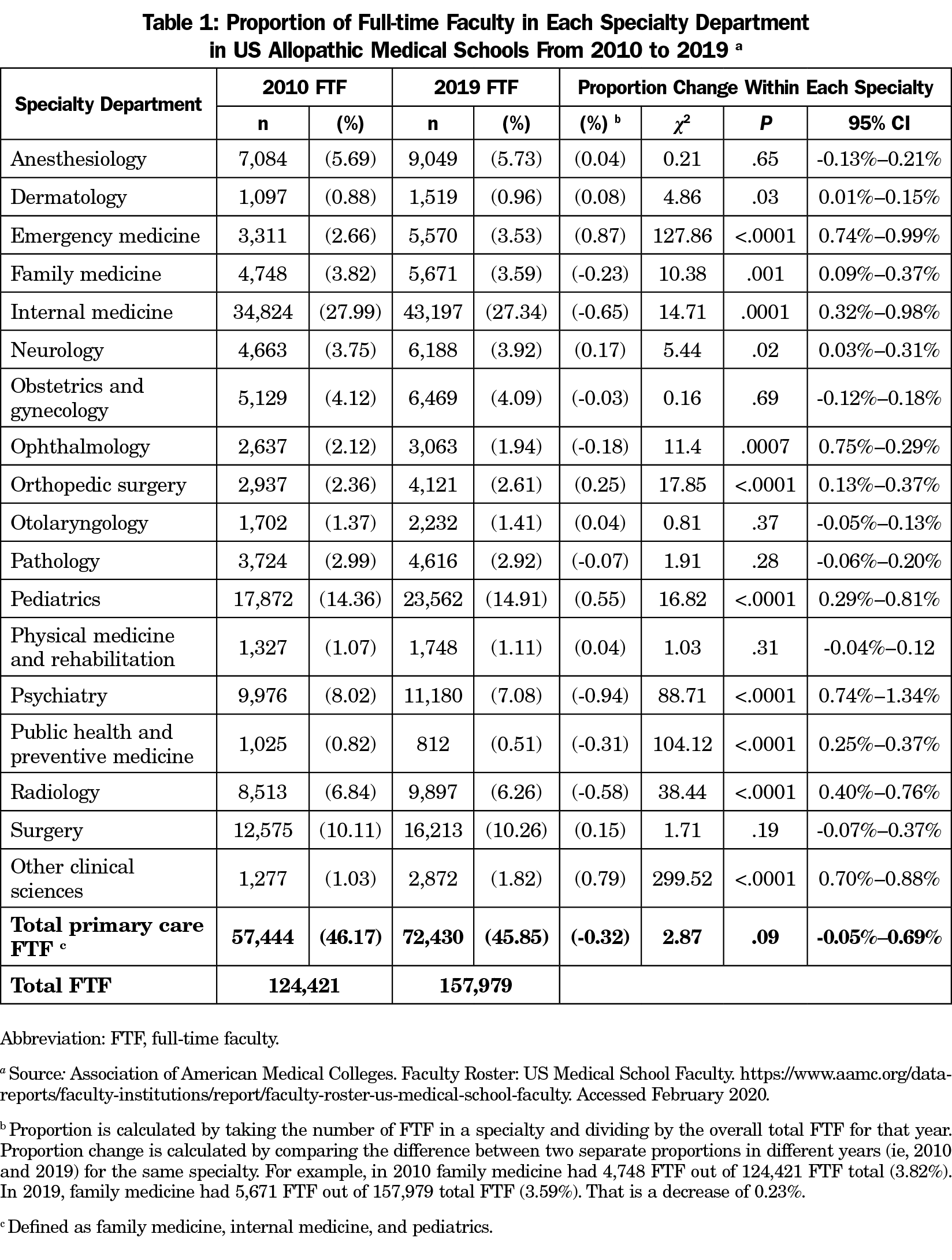Robust academic departments of family medicine are crucial to the ongoing development of the specialty, the recruitment of students, and preparation of trainees.1-4 These departments must have adequate numbers of well qualified faculty to conduct their multiple missions in patient care, education, research, and scholarship in family medicine, as well as to play appropriate roles in the management and development of medical schools, academic health systems, and related institutions.4,5
The most recent data show that family medicine departments in United States allopathic medical schools had 5,671 full-time faculty (FTF) members as of December 2019.6 This increase of 932 (19.4%) individuals since January 2010 appears to validate a decade of academic progress, but actually represents a decreasing proportion of family medicine FTF when compared to the total number of FTF in other specialty departments (see Table 1). The total number of FTF in all clinical specialties rose from 124,421 in 2010 to 157,979 in 2019, an overall increase of 27.2%. Of the number of full-time faculty in the 18 clinical specialties included in the database, family medicine dropped from the eighth largest academic specialty in 2010 to ninth largest in 2019, with neurology overtaking family medicine in 2019. The top seven (internal medicine, pediatrics, surgery, psychiatry, radiology, anesthesiology, and obstetrics and gynecology) maintained their ranking over the decade.
Several well established specialties achieved an increasing proportion of FTF, including orthopedic surgery, dermatology, neurology, and pediatrics (Table 1). However, family medicine was one of eight specialty departments with a statistically significant decreased proportion of FTF from 2010 to 2019 (χ2 [1]=10.38, P=.001, 95% CI 0.09% to 0.37%). Decreasing proportions of FTF were also recorded for psychiatry, internal medicine, radiology, public health and preventive medicine, ophthalmology, pathology, and obstetrics and gynecology; and all but pathology and obstetrics and gynecology were a statistically significant decrease. While the decrease in the proportion of family medicine FTF in allopathic medical schools was not the largest, any drop is disappointing and highly undesirable. It is also important to note that the dramatic increase in the proportion of FTF in emergency medicine and other clinical departments probably reflects the creation of new departments and positions.
When comparing family medicine to other traditionally termed “primary care” specialties (internal medicine and pediatrics), the differences in FTF numbers across departments are striking. With 5,671 FTF in 2019, family medicine is one-eighth the size of internal medicine (43,197) and one-fourth that of pediatrics (23,562). This large size difference is most likely due to the inclusion of faculty members from multiple subspecialty areas in both internal medicine and pediatrics. Also, while the overall number of primary care FTF increased from 57,444 in 2010 to 72,430 in 2019, the proportion of primary care FTF in US allopathic medical schools decreased from 46.2% in 2010 to 45.6% in 2019 (χ2 [1]=2.87, P=.09, 95% CI -0.05% to 0.69%).
These data are based on reports from medical schools and are limited to individuals holding full-time appointments in departments of family medicine and 17 other clinical specialties. They do not include part-time or volunteer faculty members, and others who contribute to the academic growth of the specialty. Family medicine traditionally relies on volunteer clinical faculty to supplement full-time paid faculty, and these numbers are unknown.
Nevertheless, the data demonstrate that although total numbers of FTF in academic departments of family medicine have grown over the past decade, the proportion of full-time family medicine faculty is decreasing and is dramatically out paced by many other clinical specialties.
Without additional growth, family medicine’s ability to attract students and influence curricular and policy decisions within medical schools will be limited. The potential of the specialty to address the health care needs of the population will not be reached until there is greater parity of full-time family medicine faculty in academic health centers.




There are no comments for this article.